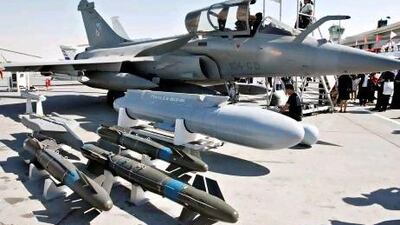There's a dogfight fight going on involving the makers of the most advanced combat aircraft in the world's arsenal.
It is being fought over the contracts to supply the next generation of fighters to countries including Brazil and India.
Standing on the sidelines is the UAE, with a requirement for 60 medium multi-role combat aircraft by 2017, and a reputation for getting the best, for the cheapest deal when it comes to defence procurement.
Over the past few weeks one plane maker has emerged as a front runner - France's Dassault, with its tried and tested Rafale. But the competition is not lying down. Another European plane maker, EADS with the Typhoon; Sweden's SAAB Gripen; and the US giants Boeing and Lockheed Martin with their F15, F16 and F18 variants, are still in play.
The UAE is faced with sorting through their competing claims.
Up until the beginning of this month, Rafale was dead; killed by a damning statement in November by Sheikh Mohammed bin Zayed, Crown Prince of Abu Dhabi and Deputy Supreme Commander of the Armed Forces."Regrettably, Dassault seem unaware that all the diplomatic and political will in the world cannot overcome uncompetitive and unworkable commercial terms," he said.
Then, on January 31, Dassault announced it had been made preferred bidder for the contract to supply the Indian Air Force with 126 Rafales, with a potential second batch bringing the total to 206. The total order could be worth US$20 billion (Dh73.46bn). Suddenly there were stories that Dassault and the UAE were still talking and the French press were saying the French president Nicolas Sarkozy could be visiting Abu Dhabi next month to sign a deal. The UAE, meanwhile, is still keeping its own counsel.
The also-ran on the India deal was EADS' Typhoon.
Both aircraft had undergone stringent evaluations by the Indian Air Force, but the French had offered more technology transfer, and an arrangement whereby the first 18 aircraft would be built in France and the remainder at Hindustan Aerospace in Bangalore. They were also said to be cheaper.
Other possible customers for the Rafale stepped forward. From being a French venture that had failed to secure a single overseas customer and was in danger of having its production line shut down, Rafale was flying again.
Brazil's FX2 competition for 36 next-generation fighters worth $2.2bn, with potential follow-on orders for up to 120 aircraft, is up for grabs. Brazil was already talking to Dassault, EADS, Saab, Russia's Sukhoi and Boeing.
In Brazil, the Rafale had not been a front-runner, but after India's announcement the Brazilians suddenly wanted to know what was in Dassault's package.
Yes, Rafale was aircraft carrier-capable, important for the Brazilian Navy, but the price at $9bn was the highest among the bidders. Boeing's Super Hornet was also carrier-capable, and at $7.7bn, cheaper and Boeing's passenger aircraft division offered major offset possibilities for Brazil's commercial airliner industry. EADS, the maker of the Typhoon, offered similar benefits via Airbus. But fighter contracts are complex. On price, even if there is an initial loss, there will be an opportunity to catch up, upgrading aircraft to a next level, four or five years hence. And other strategic concerns can trump up-front commercial benefits.
India's decision to prefer the Rafale to the Typhoon was based on history.
The Indian Air Force is a satisfied user of French fighters, going back to the 1950s, and France has been a staunch ally.
During the 1999 Kargil campaign against Pakistan, India obtained French clearance to urgently adapt Israeli laser-guided bombs for its French-made Mirage fighters.
On the other hand, the 1998 US arms embargo after India's nuclear test has not been forgotten in New Delhi. France was the only western nation not to impose sanctions.
The weapons systems and sensors for the Rafale are mostly French-made, and thus not subject to a third-party embargo. The Typhoon is produced by a consortium of four nations, each with different foreign policies and different attitudes to arms exports.
One of them, Germany, has dithered over technology transfer with India on previous deals, and both German and Italian law prohibits deliveries of weapons and spares to warring nations. Also, Typhoon's air-to-air missiles include the US-made AIM-120 Amraam and the German-led IRIS-T, and its primary air-to-ground weapon is the US-made Paveway laser-guided bomb system.
Could India rely on those allies to keep her supplied, or could an India at war see its supply of weapons and spares shut down?
In Brazil, the newspaper O Estado de Sao Paulo quoted the influential Workers' Party deputy leader Jose Genoino as saying: "France is always the better partner ... we don't know what is going to happen in 10 years so that we will be able to guarantee our spare parts. The USA, traditionally, does not transfer technology … We want to seek the lowest price with the most technology transfer."
Meanwhile, the UAE is offering no hints. Typhoon is still in the running, and if Dassault is right, so is Rafale.
"It won't just be about performance," said one defence industry analyst, who declined to be named.
twitter: Follow our breaking business news and retweet to your followers. Follow us

